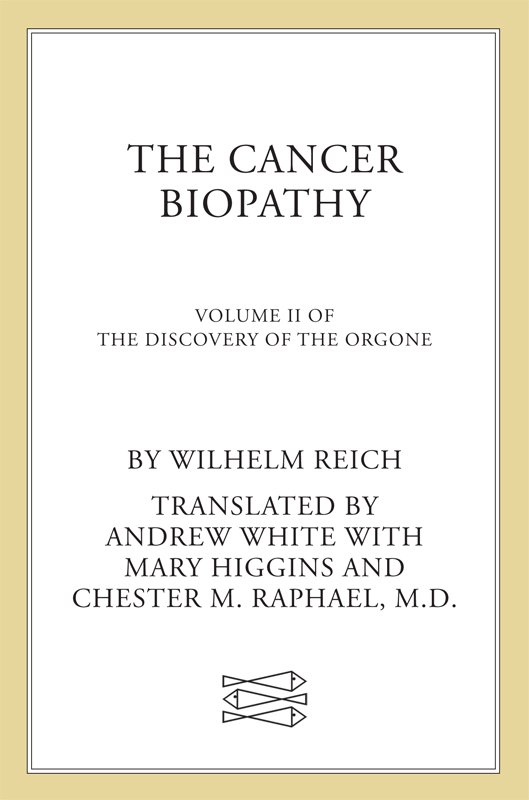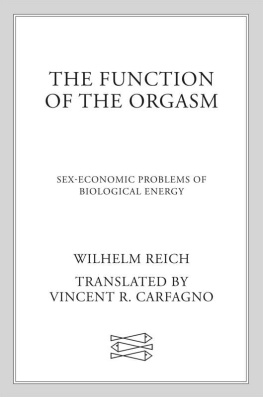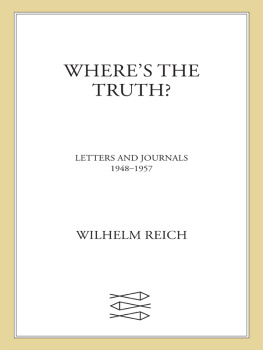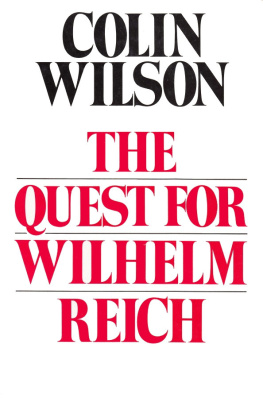Wilhelm Reich - The Cancer Biopathy
Here you can read online Wilhelm Reich - The Cancer Biopathy full text of the book (entire story) in english for free. Download pdf and epub, get meaning, cover and reviews about this ebook. City: New York, year: 1977, publisher: Farrar, Straus and Giroux, genre: Science. Description of the work, (preface) as well as reviews are available. Best literature library LitArk.com created for fans of good reading and offers a wide selection of genres:
Romance novel
Science fiction
Adventure
Detective
Science
History
Home and family
Prose
Art
Politics
Computer
Non-fiction
Religion
Business
Children
Humor
Choose a favorite category and find really read worthwhile books. Enjoy immersion in the world of imagination, feel the emotions of the characters or learn something new for yourself, make an fascinating discovery.

- Book:The Cancer Biopathy
- Author:
- Publisher:Farrar, Straus and Giroux
- Genre:
- Year:1977
- City:New York
- Rating:3 / 5
- Favourites:Add to favourites
- Your mark:
- 60
- 1
- 2
- 3
- 4
- 5
The Cancer Biopathy: summary, description and annotation
We offer to read an annotation, description, summary or preface (depends on what the author of the book "The Cancer Biopathy" wrote himself). If you haven't found the necessary information about the book — write in the comments, we will try to find it.
The Cancer Biopathy — read online for free the complete book (whole text) full work
Below is the text of the book, divided by pages. System saving the place of the last page read, allows you to conveniently read the book "The Cancer Biopathy" online for free, without having to search again every time where you left off. Put a bookmark, and you can go to the page where you finished reading at any time.
Font size:
Interval:
Bookmark:


The author and publisher have provided this e-book to you for your personal use only. You may not make this e-book publicly available in any way. Copyright infringement is against the law. If you believe the copy of this e-book you are reading infringes on the authors copyright, please notify the publisher at: us.macmillanusa.com/piracy.
Contents
I.
II.
III.
IV.
V.
VI.
VII.
VIII.
IX.
X.
Love, work and knowledge are the well-springs of our life. They should also govern it.
W ILHELM R EICH

Foreword
Reichs theory that cancer is not primarily a tumor that arises mysteriously in an otherwise healthy organism but a systemic disease due to chronic sexual starvation will startle the average person who tends to view a disturbance of sexuality as distressing but not pathogenic. It will also enrage many who, because of moral prejudice, find such a connection offensive and untenable. Wilhelm Reich, with unerring appreciation for the relatedness of all natural phenomena, disregarded this prejudice and included the orgasm as a subject for serious investigation. His studies eventually led to an inquiry into the exact nature of the energy expressed in the orgasm and to its demonstration not only in the living organism but as the common functioning principle in nature.
The path Reich followed to the discovery of this ubiquitous energy, which he called orgone, is described in The Function of the Orgasm. Here, in The Cancer Biopathy, he details the actual discovery of orgone energy and reveals its practical importance to the problem of cancer. In so doing, he makes a contribution of enormous significance to an understanding of the gravest and most perplexing disease afflicting humanity today.
First published in 1948, The Cancer Biopathy is virtually unknown. It had an extremely limited distribution and was subsequently forced out of print by an injunction that caused Reichs books to be withheld or destroyed by an agency of the United States government. Fortunately, this new translation appears concurrent with a growing openness to innovative approaches to cancer.
At the basis of Reichs cancer theory is orgone energy, which can be utilized in the study of all natural phenomena and in the investigation, treatment, and prevention of disease. One would think that the actual proof of the existence of a cosmic energy, about which man has speculated during the entire course of his history, would be eagerly received. However, the incapacity of the average human being to experience or understand his own bodily sensationswhich are manifestations of the movement of this energyhas made him reject the reality of a specific force that governs his organism. Consequently, he has viewed the discovery of orgone energy by Reich as a fantasy or a fraud.
A major obstacle to an understanding of Reichs cancer theory is the conventional, mechanistic way of comprehending disease. Until fairly recently, actually less than a hundred years ago, diseases were attributed to the effects of the interaction of many variables in the individual and his environment. However, beginning with the investigations of Pasteur and Koch, the doctrine of specific etiology emerged, according to which a disease is caused by a specific factor, e.g., a bacterium or a virus or a hormonal deficiency. Modern medicine is based on this mechanistic viewpoint and it is the one that is presently being supported with vast federal grants in the investigation of cancer. Enthusiasm for this approach derives from the knowledge that a single, isolated factor can be introduced to produce disease in an experimental animal or that a mechanical procedure or chemical substance, often serendipitously discovered, can be effective in the treatment of disease. There are prominent scientists who take issue with this approach and assert that the search for a specific causal factor is futile. Nevertheless, the search continues.
Several individual causes for cancer are being investigated at this time, among them the viral, psychosomatic, and biochemical theories. Thus, some investigators are convinced that cancer is an infectious disease of viral origin and believe that a vaccine is soon to be developed. Others have drawn attention to the possibility of an interactional psychosomatic etiology and have speculated about the relationship of psychic depression, lack of aggression, etc., to the development of malignant tumors. Still others suggest that psychological factors upset the hormonal balance of the organism or depress the mechanisms of immunity, thereby contributing to the etiology of cancer. Finally, in the biochemical area, the long-neglected finding by Otto Warburg that the normal oxidative processes are irreversibly damaged in the cancer cell and replaced by anaerobic processes is being reconsidered today, in view of the observation that lack of oxygen appears to contribute to the development of cancer.
Despite the interest stimulated by these diverse theories, it is evident that many questions about etiology remain unanswered and that much is obscure and confused. For instance, if viruses are involved, where or how do they originate? If there is something more fundamental than viruses at work, something chemical, what is it? If the emotions are etiologically involved, how do they actually produce cancer? That there is a relationship between cancer and viruses, the emotions, the lack of oxygen, etc., appears certain, but what it is or how it brings about the malignant transformation in the tissues is unknown.
In the absence of known etiology, the treatment of cancer has been largely symptomatic and the results have been unpredictable and generally discouraging. In fact, the suffering of the cancer patient is often due as much to the means that are employed to treat the symptoms as to the disease itself. Since the tumor is the most visible feature of the disease and is considered by most investigators to be the disease per se, treatment consists either in its excision or in an attempt to destroy it by radiation or chemicals. Controversy rages as to the value of these measures. For instance, there is constant disagreement about how much tissue need be removed in order to make certain that there are no cancer cells left that will invade and destroy the surrounding healthy tissue. George Crile, Jr., M.D., of the Cleveland Clinic, has found many surgical procedures to be excessive and has complained that in our haste to stamp out cancer by indiscriminate use of surgery, we are forgetting the patient and even disseminating the disease. Yet, despite the limitations in treating the disease by removing or destroying the tumor, standard medical practice considers the tumor to be virtually the only target for therapeutic intervention because of the mechanistic premise that the tumor arises de novo in an otherwise healthy organism.
In The Cancer Biopathy, Reich presents a functional theory of cancer that explains the origin and development of the disease and offers possibilities for its treatment and, more importantly, its prevention. This is accomplished without excluding the prevalent speculations about the relationship of the disease to infection, emotional disorder, damage to cellular metabolism, the value of simple excision of large tumors, etc. The theoretical cancer virus is undoubtedly related to Reichs T-bacilli, which produced cancerous tumors in experimental animals, thus supporting the present infection theory. However, to accommodate Reichs views, the infection theory would have to include the fact that the T-bacillus originates endogenously from the bionous disintegration of living substance. (This, of course, discredits the metaphysical theory of air germs from which all bacteria are presumed to develop.) The psychic depression or lack of aggression, noted by the psychosomaticists, is Reichs characterological resignation. But, for Reich, resignation is not just an interesting finding that is obscurely involved in the origin of the disease; it is the first phase of a shrinking process that results from a disturbance in the discharge of biosexual energy. The current theory of oxygen deficiency on the cellular level, originally noted by Warburg, is not an isolated, unexplained finding but, according to Reich, the internal biochemical expression of the impairment of external respiration. In other words, in Reichs theory of cancer these and other factors are not miscellaneous and unconnected; they are symptoms of a systemic disease that has its origin in the prolonged stagnation of the organisms biological energy. That is, these factors have a common origin and then become capable of functioning autonomously, thereby giving the impression of being of primary etiological significance.
Font size:
Interval:
Bookmark:
Similar books «The Cancer Biopathy»
Look at similar books to The Cancer Biopathy. We have selected literature similar in name and meaning in the hope of providing readers with more options to find new, interesting, not yet read works.
Discussion, reviews of the book The Cancer Biopathy and just readers' own opinions. Leave your comments, write what you think about the work, its meaning or the main characters. Specify what exactly you liked and what you didn't like, and why you think so.



